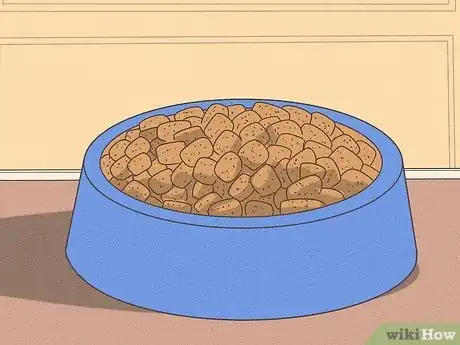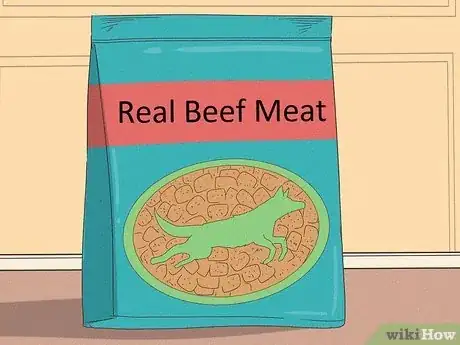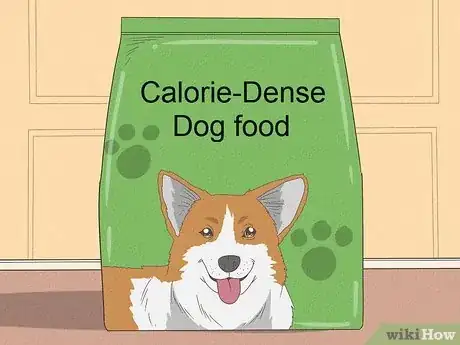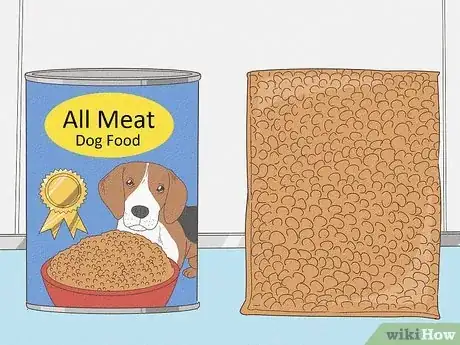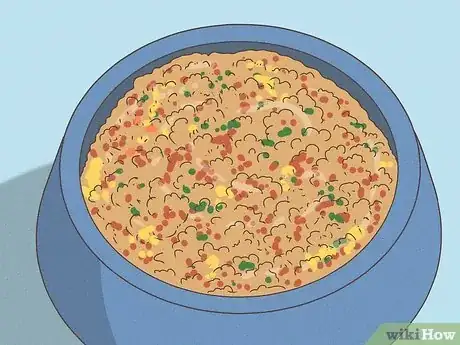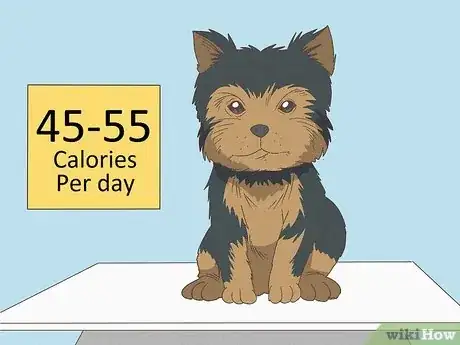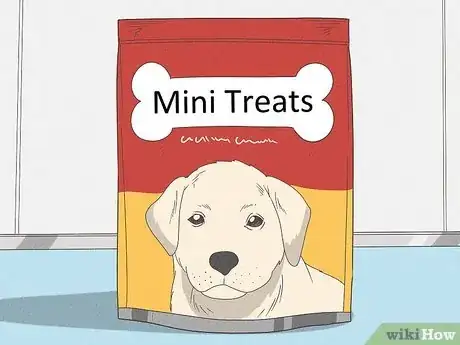This article was co-authored by Ryan Corrigan, LVT, VTS-EVN. Ryan Corrigan is a Licensed Veterinary Technician in California. She received her Bachelor of Science in Veterinary Technology from Purdue University in 2010. She is also a Member of the Academy of Equine Veterinary Nursing Technicians since 2011.
There are 8 references cited in this article, which can be found at the bottom of the page.
This article has been viewed 51,446 times.
You want your Yorkie puppy to grow up happy and healthy, living a full and comfortable life. To do so, they must be fed properly. Feeding your puppy may seem complicated at times, but if you are careful to choose foods with healthy ingredients and stick to a recommended feeding regimen, you can be sure you’re providing them with the essentials they need to thrive.
Steps
Weaning Your Puppy
-
1Add canine milk replacer to their food. Depending how young your puppy is when you bring them home (8 weeks is usually the earliest breeders will allow), you may need to transition them from liquid to solid foods. Most of the time, this step will be done by the breeder when the puppy is between three to 6 weeks old. Ask your breeder if they’ve already made this transition. If not, add a quality canine milk replacer to their food to help them transition from a liquid diet to a solid one.[1]
- If your puppy is not eating any solid food when you bring them home, start by mixing a 50/50 ratio of milk replacer to water. Dip their noses in this mixture 2 or 3 times a day until they are drinking it on their own. They will usually catch on within one to four days.[2]
- If they have been eating some solid food, begin by adding enough milk replacer to make their food the consistency of soup. Crush the kibbles a bit or break up the canned food some to make it easier to digest. Over the next 2 to 3 weeks, gradually include less and less of the milk replacer every few days until they are eating only solid food.[3]
- Use only a good quality canine milk replacer. Don’t use cow or goat milk, or any other type of liquid.[4] Find out what milk replacer the breeder was using. Try not to change the brand unless you have to.
-
2Mix current food with new food. Gradually transition your Yorkie puppy from the food they were eating at the breeder’s to the new food you will be feeding them. This will help prevent digestive issues they might experience from abruptly switching from 1 food to another. If you also have to transition them from liquid to solid food, this can be done at the same time.
- Feed them the same food they’ve been eating (find out from the breeder or pet store) for 2 weeks after you bring them home.
- Once this 2 weeks is over, start mixing their food. Begin by mixing a 3:1 ratio of old food to new for 5 days.
- Next, mix a 1:1 ratio for 5 days.
- Finally, give them a 1:3 ratio of old food to new for another 5 days. Once this is complete, you are safe to feed them only their new food.[5]
Advertisement -
3Leave their food out all day. The weaning age for puppies starts when they are between 4 and 7 weeks old and goes up to 3 months. At this stage, puppies need to be free fed, meaning you should leave their food out all day long so they can eat whenever they need. This helps prevent hypoglycemia, or low blood sugar, and promotes growth.[6]
- By 10 weeks, your dog should be receiving fixed amounts of food on a schedule. Talk to your veterinarian to get recommendations based on your puppy's size and age.
Choosing the Right Food
-
1Ensure meat is the first ingredient. Most people choose to feed their puppy a manufactured food, in either a canned or kibble variety. Ingredients in manufactured dog foods must be listed in descending order on the nutrition label, so look for a brand in which meat is the first item listed.
- Make sure the type of meat listed is a name you recognize, like chicken, lamb, or beef. Stay away from brands containing generic “meats” that don’t specify what kind is actually in the food.[7]
- In addition, check the label to make sure at least 1 other type of meat is included in the first 3 to 5 ingredients. This can also include high-quality dairy products like eggs. Try to avoid brands in which the top 5 ingredients include mostly grains, like wheat meal and wheat middlings.[8]
-
2Choose a calorie-dense food. Small dogs need a high-calorie diet because they expend a lot of energy throughout the day, and therefore burn more calories. Look for foods that are made specifically for toy breeds and small dogs. These foods will have a higher calorie content that those made for bigger dogs.[9]
- Once your dog is older, you can look for a dry dog food specifically for Yorkies, like Royal Canin's Yorkshire Terrier Dry Dog Food or Eukanuba's Yorkshire Adult Dog Food. This breed-specific food provides a high protein content, is well-balanced in carbohydrates and fats, and includes omega-3 fatty acids to keep their coats looking and feeling silky. It also has an aroma that appeals to Yorkies, which are known for being picky eaters.[10]
-
3Decide between canned or kibble. Kibble is usually considered a better choice for Yorkies than wet canned food. Yorkies are known to develop dental problems and the dry, brittle texture of kibble will help clean their teeth. However, both are safe if they include quality ingredients. Much of your decision will depend upon which type of food your puppy prefers.[11]
- Wet foods tend to have more sugars and are often a little less healthy for your dog.
-
4Pick a food with small pieces. If you choose a canned food, you can skip this step. However, if you are going with a kibble, be sure to pick 1 with small, bite-sized pieces. Doing so will make it easier for your Yorkie to digest their food.
- This is a common feature for kibble manufactured for smaller dogs, so check your brand to see if the pieces are already small.
-
5Make home-cooked food. While most people choose a manufactured food for their Yorkie puppy, making your own food for them is also a good choice. Many argue it is a better choice since this eliminates the possibility that there are chemicals, fillers, and coloring in it. Your puppy’s food should be 1/3 protein and 2/3 vegetables and grains.[12] If you choose to make your puppy’s food, ensure you include the following items:
- Meat: You can use a variety of meats like lean chicken and ground beef, as well as turkey, lamb, veal, bison, and fish.
- Vegetables: String beans, carrots, sweet peas, and spinach are all good choices.
- Carbohydrates: These can include sweet potatoes or regular potatoes, white or brown rice, and pasta.
- Fruits: Blueberries, raspberries, mangos, and bananas all work well.
- Extras: For some additional variety, provide whole white yogurt, cottage cheese, and eggs.[13]
Following a Feeding Regimen
-
1Determine how much to feed your puppy. Growing puppies usually need 45 to 55 calories per pound of body weight per day. The type of food you decide to feed your puppy—manufactured or homemade—will impact the amount you need to give them.
- If you’re feeding your puppy a manufactured food, check the label. Manufactured dog foods generally provide serving sizes according to your dog’s weight.
- If you’re providing homemade food, you’ll likely need smaller portions because it is more calorie-dense than manufactured food.[14]
-
2Feed your puppy several small meals. Once your puppy is weaned (usually around 3 months), you should start feeding them scheduled meals. Feed your puppy 3 to 4 small meals a day—morning, lunchtime, early evening (if you’re feeding them four meals), and evening. They should eat their last meal at least 2 hours before bedtime.
- Continuing to free-feed at this age can make housebreaking much more difficult because you won’t know when your dog needs to go to the bathroom. Additionally, it could cause health problems if your dog overeats and becomes obese. Having a well-scheduled day also helps promote good behavior.[15]
-
3Leave room for snacks and treats. Yorkies have very small stomachs so you must take into account how snacks and treats will affect their meals for the day. Generally, they should only be given as a reward for good behavior or when you are command training.
- Stay away from brightly-colored treats, which often contain a lot of chemicals. Look for white or cream-colored treats instead.
- Good homemade snacks include items like baby carrots or frozen blueberries.[16]
Warnings
- Terms like “natural” and “premium” have no legal definition, so don’t base your decision on which food to purchase on these terms.⧼thumbs_response⧽
- Many commercial brands have ingredients that don’t benefit your puppy’s health like artificial coloring and flavor, as well as chemical preservatives. These things can cause health issues ranging from allergies to digestive problems.⧼thumbs_response⧽
- Feeding your Yorkie quality proteins is important. Many manufactured dog foods add meat by-products in order to meet their required protein quota. This can include animal body parts or things like road-kill.⧼thumbs_response⧽
- Many commercial dog foods also contain fillers, which hold no nutritional value. Because of this, even though your puppy might ingest the desired amount of food, a percentage of this food will pass right through their body because there are no nutrients to absorb. This can cause malnutrition and behavioral issues.⧼thumbs_response⧽
References
- ↑ http://www.yorkieinfocenter.com/yorkshire-terrier-feeding
- ↑ http://www.vcahospitals.com/main/pet-health-information/article/animal-health/breeding-for-dog-owners-caring-from-birth-to-weaning/489
- ↑ http://www.vcahospitals.com/main/pet-health-information/article/animal-health/breeding-for-dog-owners-caring-from-birth-to-weaning/489
- ↑ http://www.yorkieinfocenter.com/yorkshire-terrier-feeding
- ↑ http://www.elvisyorkshireterrier.com/yorkshire-terrier-puppy-care.php
- ↑ http://www.yorkieinfocenter.com/yorkshire-terrier-feeding
- ↑ http://dogtime.com/dog-health/general/216-food-nutrition**
- ↑ http://dogtime.com/dog-health/general/216-food-nutrition**
- ↑ http://dogfood.guru/what-is-the-best-dog-food-for-a-yorkie/
- ↑ http://thehappypooch.com/best-dog-food-for-yorkies/
- ↑ https://herepup.com/best-dog-food-for-yorkies/
- ↑ http://dish.allrecipes.com/homemade-pet-food/
- ↑ http://www.yorkieinfocenter.com/yorkshire-terrier-feeding
- ↑ http://www.yorkieinfocenter.com/yorkshire-terrier-feeding
- ↑ http://www.yorkieinfocenter.com/yorkshire-terrier-feeding
- ↑ http://www.yorkieinfocenter.com/yorkshire-terrier-feeding


